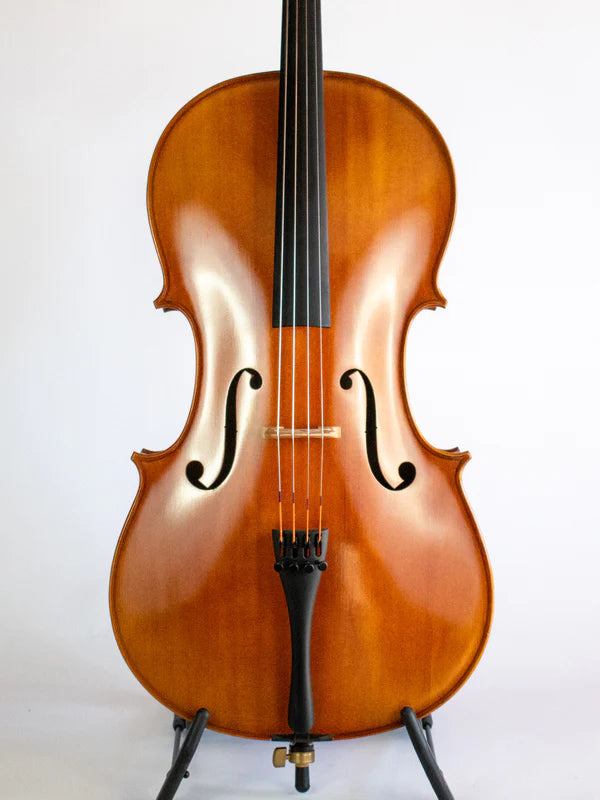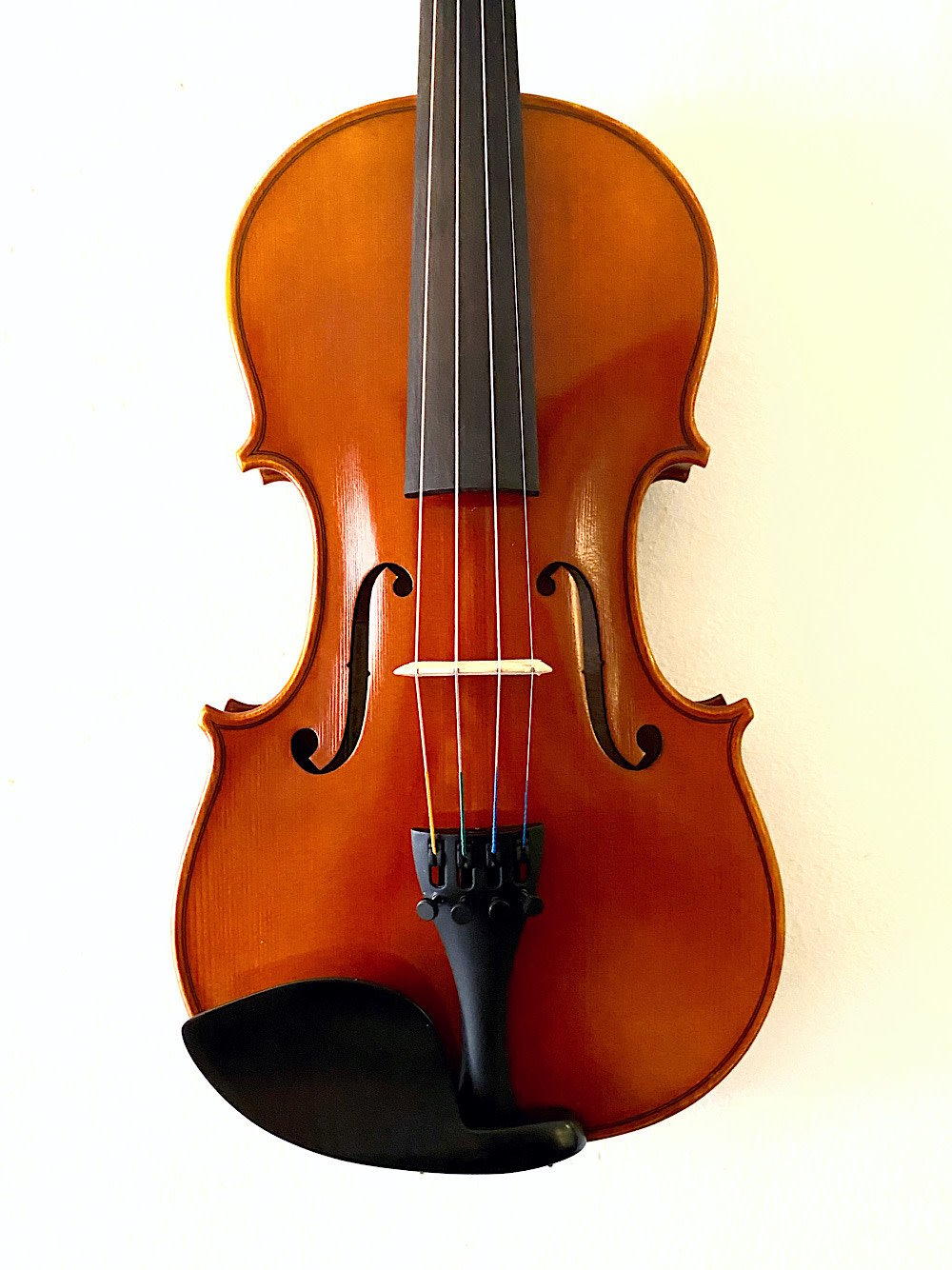Key Differences Between 1/2, 3/4, and 7/8 Size Cellos: A Comprehensive Guide
Share
Finding the perfect cello size is crucial for players of all ages and physical dimensions. Whether you're a parent searching for your child's first instrument, a teacher guiding students, or an adult with a smaller frame, understanding the key differences between fractional cello sizes can significantly impact playing comfort, technique development, and musical progression.
In this comprehensive guide, we'll explore the essential distinctions between 1/2, 3/4, and 7/8 size cellos to help you make an informed decision when selecting the ideal instrument.
Why Cello Size Matters
Before diving into specific measurements and characteristics, it's important to understand why proper sizing is so critical for cellists. Unlike many instruments, the cello requires significant physical interaction—the player must reach around the instrument's body, extend their arm down the fingerboard, and maintain proper posture for extended periods.
Playing an incorrectly sized cello can lead to:
-
Physical discomfort or pain
-
Development of poor technique
-
Difficulty reaching notes and positions
-
Reduced sound quality
-
Diminished motivation and enjoyment
-
Potential for repetitive strain injuries
With these considerations in mind, let's examine the specific differences between 1/2, 3/4, and 7/8 size cellos available in our undersize cellos collection.
Size Comparison: Dimensions and Specifications
1/2 Size Cellos

The 1/2 size cello is typically suitable for children between 7-11 years old or individuals around 4'3" to 4'8" (130-142 cm) tall. However, age is less important than physical measurements and comfort when determining the appropriate size.
Key specifications of 1/2 size cellos:
-
Back length: Approximately 29-30 inches (74-76 cm)
-
String length: Around 23-24 inches (58-61 cm)
-
Body width: About 13-14 inches (33-35.5 cm)
-
Total height with endpin retracted: Typically 38-40 inches (96.5-101.5 cm)
1/2 size cellos produce a brighter tone due to their smaller resonating chamber. While they may not match the depth and richness of larger instruments, quality 1/2 cellos still offer beautiful sound that encourages young players.
The reduced neck length and string spacing make it easier for smaller hands to navigate the fingerboard, allowing proper hand positioning and finger placement. This size is ideal for younger students who are still growing but have outgrown 1/4 size instruments.
3/4 Size Cellos

The 3/4 size cello represents an important transitional instrument, typically suitable for pre-teens or individuals between 4'8" and 5'1" (142-155 cm) tall. Many cellists spend significant time with 3/4 size instruments before graduating to full size.
Key specifications of 3/4 size cellos:
-
Back length: Approximately 33-34 inches (84-86 cm)
-
String length: Around 25-26 inches (63.5-66 cm)
-
Body width: About 15-16 inches (38-40.5 cm)
-
Total height with endpin retracted: Typically 43-45 inches (109-114 cm)
3/4 size cellos offer a noticeable improvement in tonal depth compared to smaller fractional instruments. The increased resonating chamber produces a warmer sound, approaching the richness of full-sized cellos while remaining manageable for smaller players.
This size represents a significant step up in playing experience, with string spacing and fingerboard geography that begins to prepare players for eventual transition to full-sized instruments. The additional string length requires greater finger strength and stretch, building important technical foundations.
7/8 Size Cellos

The 7/8 size cello is the final step before a full-sized instrument. This size is particularly well-suited for:
-
Teenagers who haven't reached their full height
-
Adults with smaller frames or shorter arms
-
Female cellists who find full-sized instruments uncomfortable
-
Players between 5'1" and 5'5" (155-165 cm), though individual comfort varies
Key specifications of 7/8 size cellos:
-
Back length: Approximately 36-37 inches (91.5-94 cm)
-
String length: Around 26.5-27 inches (67-68.5 cm)
-
Body width: About 16.5-17 inches (42-43 cm)
-
Total height with endpin retracted: Typically 46-48 inches (117-122 cm)
7/8 cellos offer nearly the same tonal qualities as full-size cellos with only subtle differences in resonance and projection. For many players, the slight reduction in size makes a significant difference in playing comfort without compromising sound quality.
The 7/8 size is often overlooked but can be the perfect permanent solution for many adult players. Professional-level 7/8 cellos are available and used by accomplished cellists who prioritize comfort and technique over conforming to standard sizing.
How to Determine the Right Size
Finding the correct cello size involves more than just considering height. Here are the key factors to evaluate:
Arm Length and Reach
The player should be able to:
-
Comfortably reach the scroll with their left hand
-
Wrap their hand around the neck without strain
-
Reach fourth position without excessive stretching
-
Bow comfortably at the frog near the fingerboard
Hand Size
Consider whether the player can:
-
Place four fingers on the fingerboard with proper spacing
-
Comfortably press down strings without straining
-
Reach across the fingerboard for string crossings
Sitting Position
When seated with the instrument:
-
The C-peg should be near the left ear
-
The body of the cello should rest against the sternum and left knee
-
The right arm should move freely across all strings
-
The endpin should allow proper height adjustment
Playing Comfort
Most importantly, the player should feel comfortable:
-
Maintaining proper posture for extended periods
-
Executing basic techniques without physical strain
-
Maneuvering the instrument when playing
Sound Quality Differences
The size of a cello directly impacts its acoustic properties and tonal characteristics:
1/2 Size Sound Profile
-
Brighter, more focused tone
-
Quicker response
-
Less resonance in lower registers
-
Higher string tension relative to size
-
Typically less projection
3/4 Size Sound Profile
-
More balanced tonal spectrum
-
Improved bass response over 1/2 size
-
Greater resonance and sustain
-
Moderate projection suitable for small ensembles
-
Warmer overall sound character
7/8 Size Sound Profile
-
Nearly identical to full-size tonal characteristics
-
Rich, full bass response
-
Excellent resonance across all registers
-
Strong projection suitable for orchestral playing
-
Slightly more focused sound than full-size
Pricing Considerations
Price differences between fractional cellos reflect both their size and market demand:
-
1/2 Size Cellos: Generally less expensive due to smaller materials requirements. Student models typically range from $800-$2,500, with intermediate options available up to $5,000.
-
3/4 Size Cellos: Moderately priced between smaller fractionals and full-size instruments. Quality student models begin around $1,200, with intermediate and advanced options reaching $7,000+.
-
7/8 Size Cellos: Pricing closely mirrors full-size instruments, with fewer budget options available. Expect to invest $1,500-$3,000 for good student models, with professional instruments starting around $5,000 and reaching well above $10,000.
For all sizes, consider that investing in the best quality instrument within your budget will provide better sound, playability, and resale value. Browse our complete cellos collection to compare options across various price points.
Transitioning Between Sizes
Knowing when to move to a larger size is crucial for continuing development. Signs that a player has outgrown their current instrument include:
-
Hunched posture when playing
-
Difficulty maintaining proper hand position
-
Knees significantly higher than the bottom of the cello
-
Compressed playing position
-
Decreased sound quality despite technical improvement
For detailed guidance on this important transition, read our blog post on Signs It's Time to Upsize: How to know you've outgrown your cello.
When transitioning to a larger cello, expect an adjustment period of 3-6 weeks. Players may initially experience:
-
Stretching discomfort in the left hand
-
Altered bow arm mechanics
-
Temporary inconsistencies in intonation
-
Changes in sound production
These challenges are normal and typically resolve as the player adapts to the new dimensions.
Maintenance Differences
Caring for fractional cellos involves some size-specific considerations:
1/2 Size Maintenance
-
More susceptible to bumps and damage due to often being used by younger players
-
May require more frequent bridge adjustments as young players are developing bow control
-
Typically needs lower tension strings specific to smaller instruments
-
Often benefits from more frequent cleaning due to handling by younger players
3/4 Size Maintenance
-
Standard maintenance schedule similar to full-size instruments
-
Requires properly scaled strings designed for 3/4 tension requirements
-
May need more frequent fingerboard adjustments as technique develops
7/8 Size Maintenance
-
Maintenance nearly identical to full-size instruments
-
Can often use full-size strings with minor adjustments
-
Professional setup critical for optimizing sound potential
For comprehensive maintenance guidance specific to smaller instruments, visit our Maintaining Small Cellos blog post.
Making Your Selection
When selecting between 1/2, 3/4, and 7/8 size cellos, consider these final recommendations:
-
Try before buying whenever possible - Each player's comfort level differs based on individual proportions.
-
Consult with a teacher or experienced cellist - Their expertise can help identify the optimal size for current development.
-
Consider future growth - For young players, anticipate how long the instrument will remain appropriate as they grow.
-
Focus on quality within size - A superior 3/4 cello often outperforms a mediocre full-size instrument.
-
Remember resale value - Quality fractional instruments maintain good resale value when properly maintained.
-
Don't rush transitions - Moving to a larger size too soon can hinder technique development and cause physical strain.
Conclusion
The differences between 1/2, 3/4, and 7/8 size cellos extend far beyond simple scaling. Each size represents a critical stage in a cellist's journey, offering specific advantages for physical development, technique building, and musical expression.
Whether you're selecting your child's first appropriate-sized instrument, transitioning between sizes as a developing player, or finding your perfect match as an adult with smaller proportions, understanding these key differences will help you make an informed decision. Remember that the "right" cello is ultimately the one that feels comfortable, produces beautiful sound, and inspires regular practice and musical growth.
Explore our undersize cellos collection to find the perfect instrument for your unique needs, or contact our experienced team for personalized sizing assistance. Your ideal cello awaits!

